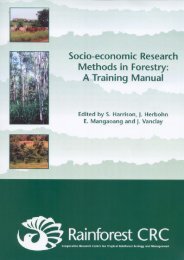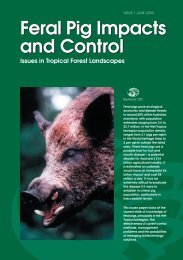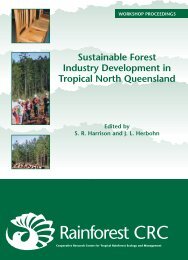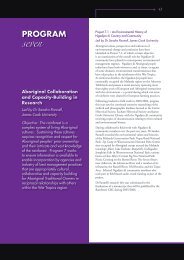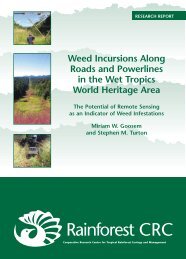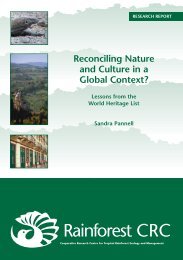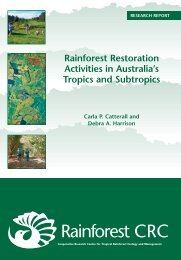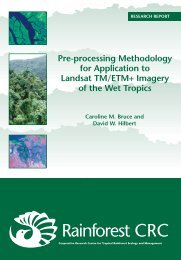Reconciling Nature and Culture in a Global Context? - Rainforest ...
Reconciling Nature and Culture in a Global Context? - Rainforest ...
Reconciling Nature and Culture in a Global Context? - Rainforest ...
Create successful ePaper yourself
Turn your PDF publications into a flip-book with our unique Google optimized e-Paper software.
S<strong>and</strong>ra PannellWhile a study on alternative livelihood preferences conducted by TNC states that “villagersfrom Kampung Komodo expressed an <strong>in</strong>terest <strong>in</strong> tourism activities” <strong>and</strong> also requestedassistance from the Park Authority for h<strong>and</strong>icraft development <strong>and</strong> “<strong>in</strong> tra<strong>in</strong><strong>in</strong>g to becomePark staff” (PHKA <strong>and</strong> TNC 2000, Vol. 1: 69), it appears from the experience of Komodoisl<strong>and</strong>ers that tourism <strong>and</strong> tra<strong>in</strong><strong>in</strong>g are not the gilded pathways to “economic prosperity”promised <strong>in</strong> the Plan. This is not so surpris<strong>in</strong>g given that the k<strong>in</strong>d of tourism promoted <strong>in</strong> thePlan, so-called ‘eco-tourism’, is depicted as “visit<strong>in</strong>g natural areas to view <strong>and</strong> enjoy the plant<strong>and</strong> animal life with m<strong>in</strong>imal or no impact on the environment” (loc. cit.). Contrary to<strong>in</strong>formation posted on TNC’s website, there is little, if any, evidence of TNC “establish<strong>in</strong>gecotourism as a means of susta<strong>in</strong>able <strong>in</strong>come for local villagers”. Furthermore, given theaforementioned response of Park staff to the <strong>in</strong>volvement of local people <strong>in</strong> tourism, <strong>and</strong> thegeneral view espoused <strong>in</strong> the Plan of the resident communities as ‘poorly educated’, thesuggestion of tra<strong>in</strong><strong>in</strong>g local people to become rangers appears as noth<strong>in</strong>g more than thePlan pay<strong>in</strong>g lip-service to the developmental mantra of ‘capacity build<strong>in</strong>g’ <strong>and</strong> ‘communityengagement’ promoted by TNC.Judg<strong>in</strong>g by conditions at the Park’s ma<strong>in</strong> visitor centre at Loh Liang, it appears that lipserviceis also paid to the idea of manag<strong>in</strong>g the World Heritage-listed values of KomodoNational Park. While bait<strong>in</strong>g <strong>and</strong> feed<strong>in</strong>g the dragons officially ceased more than a decadeago, based on my observations <strong>in</strong> October 2005, Park staff at Loh Liang feed their kitchenrefuse <strong>and</strong> food scraps to a resident group of lizards on a thrice daily basis. In addition,Komodo lizards, as well as wild pigs <strong>and</strong> deer, scavenge <strong>in</strong> the open rubbish pit establishedless than 100 metres away from the staff kitchen. In the absence of a patrol boat, the Park’srangers are largely conf<strong>in</strong>ed to the ranger station, except on those occasions when a charterboat arrives with tourists. Tourists to Komodo Isl<strong>and</strong> are prohibited from ventur<strong>in</strong>g outside ofthe Loh Liang facility by themselves. While this regulation is justified by reference to the‘dangerous’ nature of the dragons, it also produces some useful economic outcomes. Toview the dragons at Banu Nggulung or undertake one of the ‘nature walks’ on the isl<strong>and</strong>,visitors are required to pay for the services of a ranger to guide them on these out<strong>in</strong>gs.Payments from guided walks, together with the entrance fee, camera / video surcharge, <strong>and</strong>any overnight accommodation charges, comprise the ma<strong>in</strong> source of tourism-generatedrevenue <strong>in</strong> the Park. On guided tours around the Loh Liang facility rangers readily useforked sticks to prod sup<strong>in</strong>e dragons <strong>in</strong>to action for the benefit of camera-wield<strong>in</strong>g tourists.Increas<strong>in</strong>gly, the human-habituated Komodo dragons found ly<strong>in</strong>g around <strong>and</strong> underneath theraised staff canteen at Loh Liang are the only lizards seen by tourists. The cessation of thegoat-gobbl<strong>in</strong>g spectacle at the official dragon-view<strong>in</strong>g area has resulted <strong>in</strong> the creation of‘natural’ dragons, too ‘wild’ to hang around the view<strong>in</strong>g area to satisfy the curiosity ofirregular visitors.In late 2005, on-ground ‘management’ of the natural values of the park, <strong>in</strong> particularprotection of the endangered Komodo monitor, certa<strong>in</strong>ly contravened key elements of thecurrent management plan, while the daily practices of park staff stood <strong>in</strong> stark contrast to themany signs erected around the facility rem<strong>in</strong>d<strong>in</strong>g visitors to remove all rubbish from the Park.Indeed, if my stay at Loh Liang is anyth<strong>in</strong>g to go by, on-ground ‘management’ of KomodoNational Park amounts to noth<strong>in</strong>g more than feed<strong>in</strong>g the dragons, guid<strong>in</strong>g fee-pay<strong>in</strong>g touriststo <strong>and</strong> from the dragon view<strong>in</strong>g site for a couple of hours per day, <strong>and</strong> pay<strong>in</strong>g the odd visit toKampung Komodo to see what is happen<strong>in</strong>g there. In many respects, Komodo National Parkcan be viewed as a live, <strong>in</strong> situ exhibition, which creates the effect <strong>and</strong> experience of ‘real’nature, somewhat rem<strong>in</strong>iscent of W. Douglas Burden’s life-like display of the ‘Dragon lizardgroup’ at the American Museum of Natural History <strong>in</strong> New York (see Figure 5).The reality of so-called ‘management’ st<strong>and</strong>s <strong>in</strong> stark contrast to the rhetoric of managementproduced by The <strong>Nature</strong> Conservancy through its <strong>in</strong>ternet website, its Bali-based, ‘CoralTriangle Centre’, <strong>and</strong> its reams of glossy <strong>in</strong>formation sheets, media releases, assessments,reports <strong>and</strong> other publications. In this respect, TNC is highly successful <strong>in</strong> its management42




